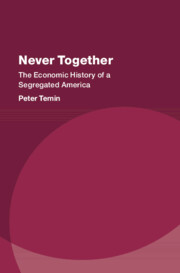Book contents
- Never Together
- Studies in New Economic Thinking
- Never Together
- Copyright page
- Dedication
- Contents
- Figures
- Tables
- Preface
- Introduction
- Part I The Nineteenth Century
- Part II The Twentieth Century
- Chapter 4 Wars and the Great Migration
- Chapter 5 Postwar Prosperity and Civil Rights
- Chapter 6 The New Gilded Age and Mass Incarceration
- Part III The Twenty-First Century
- References
- Index
Chapter 6 - The New Gilded Age and Mass Incarceration
from Part II - The Twentieth Century
Published online by Cambridge University Press: 10 February 2022
- Never Together
- Studies in New Economic Thinking
- Never Together
- Copyright page
- Dedication
- Contents
- Figures
- Tables
- Preface
- Introduction
- Part I The Nineteenth Century
- Part II The Twentieth Century
- Chapter 4 Wars and the Great Migration
- Chapter 5 Postwar Prosperity and Civil Rights
- Chapter 6 The New Gilded Age and Mass Incarceration
- Part III The Twenty-First Century
- References
- Index
Summary
The Great Migration ended in 1970 as manufacturing was replaced with electronic goods. Wages stagnated, and income inequality increased rapidly. This led to a new Gilded Age. Nixon replaced Lyndon Johnson’s War on Poverty with his War on Drugs. Blacks were opposed to Nixon’s Vietnam War, and he penalized them by incarcerating them. This, helped by state laws and President Reagan, led to mass incarceration – which became known as the New Jim Crow. Public education was reserved for suburban whites, while urban Blacks were in prison or attended underfunded schools. The Flint, Michigan, water crisis demonstrates the difficulty of urban Blacks as jobs and urban facilities disappeared. President Obama was the first Black president, elected in the financial crisis of 2008. The Supreme Court nullified the 1965 Voting Act as it had done with amendments in the 1880s. Obamacare was the most enduring achievements of Obama’s presidency.
Keywords
- Type
- Chapter
- Information
- Never TogetherThe Economic History of a Segregated America, pp. 183 - 210Publisher: Cambridge University PressPrint publication year: 2022



